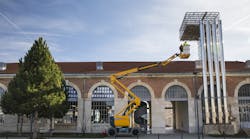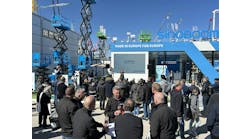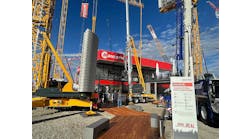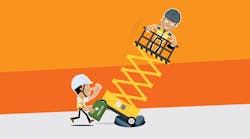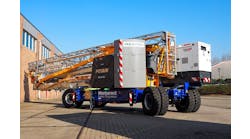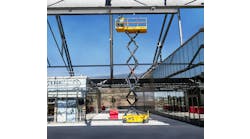RER interviews Paul Jensen, product marketing manager, Haulotte, about the company’s Quick Positioning app to help users select the right machines for a job,
Haulotte’s emphasis on electric machines, new training strategies and more.
RER: For people who have not been following the changes to the ANSI changes, can you sum up how your equipment will change on a practical jobsite level – in other words, what will the customer find different?
Jensen: Some of the changes, like guardrail height, and entry door requirements, customers and users will find no difference. Haulotte has been in compliance with most of the new standards for many years. The biggest differences in the operation of the machines will be around the load sensing system and the tilt sensing system. The new safety features will not allow some of the unsafe work habits that are sometimes seen on project sites.
Users have been able to easily ignore or disable safety warnings. Platform weight capacities were easily overloaded, and machines were working on slope angles steeper than the machines were tested for. I don’t think anyone was intentionally trying to work unsafely. Workers were usually just trying to get work done faster or work with the machines that were available to them.
With the new standards, the machines will now stop moving if the platforms are overloaded or working on steep terrain beyond the safe tilt limits. Only safe movements will be allowed to stow the platform so the operator can safely reassess their plan for working at height.
This means it becomes more important than ever to make sure the correct machine is used at the job site to make sure the work can be performed safely. Haulotte developed the Quick Positioning app, available for Apple and Android devices that guides users through selecting the best machine based on photos taken on site. The app produces a recommended machine as well as a report that can be forwarded to the rental store to start the rental order conversation.
For rental people, how will their responsibilities change with the new ANSI standards?
Rental stores have a real opportunity to partner in their customers success to make sure they have the right equipment on site the first time, every time. Instead of taking a quick order for the equipment, rental store personnel should be trained to ask a series of questions such as the type of work that will be done, the estimated loads that will be carried in the platform, the type of terrain on the job site, and if there are any safety concerns on site. Knowing that a customer will be welding, outdoors, on an unimproved site can lead to additional follow-up questions that may lead to recommending a model with a higher weight capacity and a longer outreach to accommodate the work and the terrain.
What do you suggest rental people do to communicate with their customers about the new ANSI standards?
Machines meeting the new ANSI standards are already entering the rental fleets. For the next 5 to 7 years we will have a mixed fleet of old and new standards. Some customers may be reluctant to use the newer machines if they have had a bad experience. Instead of letting new machines go unused in the yard, it’s important to communicate appropriate expectations of the machines and match those expectations with the job.
Rental stores that begin having these consultative conversations with their customers now will make sure the transition to the new standards is as smooth as possible. Instead of frustrated customers calling from the job site in the middle of the day wondering why the brand new machine they have won’t allow them to perform the same work they did last week with an older machine, customers will have confidence that the recommended machine that arrives will get the work done safely and productively.
How will training programs change with the implementation of the new standards?
Training is another opportunity for rental stores to partner with their customers and help each other be successful. Machine operators need to meet new, comprehensive training requirements.
In addition to operator training, technicians will need to be trained on the new equipment. Supervisors will need to be trained. Even workers in the platform that will not operate the machine will need a brief training course.
Making that training as easy to access as possible is another way for rental stores to partner with their customers while preventing compliance related downtime. Rental stores can invest in their own compliant training program or contract with a third-party training company to conduct on-site training. Haulotte owners can contact Haulotte about setting up on-site training for rental store employees and customers as well.
Are you seeing an increase in demand for electric and hybrid machines and is your company or will your company participate in that market?
Electrical and hybrid machines are seeing major growth in areas of the world where regulations require their use. While the U.S. currently has no low-emission zones, there is growing interest in how companies can reap the benefits of electrical machines. Haulotte has announced the Blue Strategy with the introduction of the new HA61 LE boom, the first of the new Pulseo Generation of machines. Electrically driven Pulseo Generation machines will replace the traditional internal combustion machines in the Haulotte range.
Electrical machines have the obvious benefit of lower emissions, but the Haulotte Pulseo Generation line also comes with lower TCO, and near silent operation. Haulotte has also addressed the issues of battery life, maintenance and replacement cost with the new Activ’Energy Management feature. The new feature monitors battery health, prompts technicians to perform maintenance when needed, optimizes charging voltages and time, extending battery life, shortening charging time, and reducing overall costs.
Performance characteristics that match that of a combustion machine mean the new electrical machines are just as at home working outdoors in rough terrain as they are indoors. With all these benefits it’s easy to understand why more pieces of construction equipment are showing up on job sites powered by electricity.
